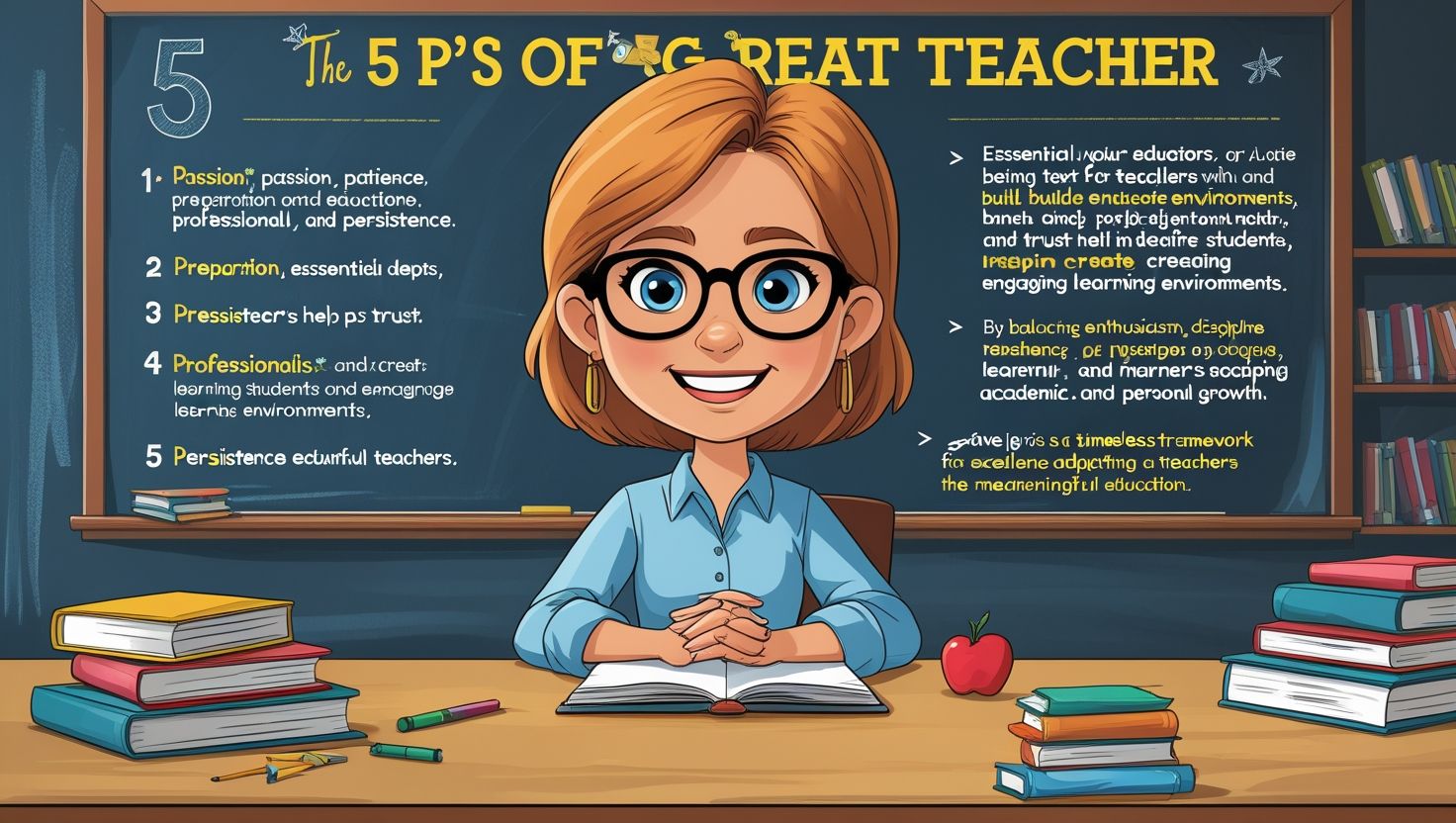Introduction
The 5 P’s of Being a Great Teacher, Teaching is more than delivering lessons; it is about shaping lives and inspiring growth. To be truly effective, a teacher must embody qualities that go beyond academic knowledge. One widely recognized framework is the 5 P’s of being a great teacher. These include Passion, Patience, Preparation, Professionalism, and Persistence. Each quality supports learning and helps create a classroom environment where students can succeed. Furthermore, these attributes ensure that teaching is not only effective but also meaningful. A great teacher understands that education is a long-term process that requires dedication and consistency. Moreover, the 5 P’s are not isolated traits but interconnected values that work together to improve teaching practices. Therefore, mastering these qualities can transform a teacher into a mentor who inspires students to reach their full potential. In today’s fast-changing world, these five qualities remain central to the success of both teachers and learners.
Passion in Teaching
Passion is the driving force that separates good teachers from great ones. A passionate teacher not only conveys knowledge but also inspires enthusiasm for learning. When students see a teacher’s genuine excitement, they are more likely to stay engaged. Moreover, passion creates an atmosphere of curiosity and energy, encouraging learners to explore subjects deeply. A teacher with passion also invests time and effort into making lessons creative and meaningful. Consequently, students develop stronger connections with the material. Passionate teachers often go beyond textbooks, using innovative strategies, stories, and real-life examples to bring lessons alive. Furthermore, passion motivates teachers to continuously improve and adapt to student needs. Without passion, teaching becomes mechanical and uninspiring. Therefore, passion is essential for making education vibrant and memorable. It is the first step in cultivating an environment where students feel motivated to achieve their best. Passion fuels purpose in every classroom.
Patience in Teaching
Patience is another vital quality of great teachers. Every student learns at a different pace, and not all concepts are easily understood at once. Teachers must remain calm and supportive when students struggle. This creates a safe environment where learners feel comfortable making mistakes and asking questions. Moreover, patience allows teachers to explain concepts multiple times without frustration. It also helps in handling behavioral issues with understanding rather than anger. A patient teacher encourages persistence in students by showing that effort matters more than speed. Additionally, patience builds trust between teachers and learners, which enhances communication. Since every classroom has diverse learners, patience ensures that no student feels left behind. Furthermore, when students see their teacher’s patience, they also develop resilience and confidence. Therefore, patience is not just a teaching strategy but a character trait that transforms challenges into opportunities for growth. It strengthens the teacher-student relationship significantly.

Preparation in Teaching
Preparation is the foundation of effective teaching. A well-prepared teacher enters the classroom with a clear plan, relevant resources, and engaging activities. Proper preparation ensures that lessons flow smoothly and objectives are met. Moreover, students respect and respond positively to teachers who are organized and confident. Without preparation, lessons may lack direction and fail to meet learning goals. Preparation also involves anticipating possible challenges, such as misunderstandings or lack of participation, and having solutions ready. Additionally, prepared teachers use a variety of teaching strategies to meet diverse learning needs. They include multimedia, real-life examples, and interactive tasks to make lessons engaging. Furthermore, preparation shows dedication, as it reflects the teacher’s commitment to student success. It also allows teachers to manage time effectively, ensuring every part of the lesson is meaningful. Therefore, preparation transforms teaching into a structured and purposeful experience that maximizes student learning outcomes.
Professionalism in Teaching
Professionalism distinguishes great teachers as role models. A professional teacher demonstrates integrity, respect, and responsibility in every aspect of the job. This includes punctuality, appropriate behavior, and ethical decision-making. Professionalism also means maintaining boundaries while still showing care and empathy for students. Moreover, professional teachers keep up-to-date with educational trends and continuously seek professional development. They collaborate with colleagues, respect school policies, and foster a positive school culture. Furthermore, professionalism extends beyond the classroom, as teachers represent their profession to the wider community. Students observe and often imitate the conduct of teachers, so professionalism influences not only academics but also character development. Additionally, professionalism builds trust among parents, administrators, and students. Therefore, it ensures that teaching remains a respected and credible profession. Ultimately, professionalism strengthens the teacher’s role as a guide, mentor, and leader, ensuring that education upholds the highest standards of excellence.
Persistence in Teaching
Persistence is the determination to continue teaching effectively despite challenges. A great teacher understands that not all lessons go as planned and that setbacks are part of the process. Persistence helps teachers maintain motivation even when students show resistance or learning outcomes are slow. Moreover, persistence reflects a growth mindset, where challenges are viewed as opportunities to improve. Teachers who persist also encourage students to adopt resilience in their own learning. Furthermore, persistence involves trying new strategies, adjusting methods, and seeking solutions until success is achieved. For example, if one approach fails, a persistent teacher finds another way to explain the concept. Additionally, persistence supports long-term student growth, as learning is a gradual process. This quality also reduces teacher burnout by fostering commitment and purpose. Therefore, persistence is essential for sustaining enthusiasm and ensuring that every student has the chance to succeed academically and personally.

Interconnection of the 5 P’s
The 5 P’s are not separate qualities but interconnected elements of great teaching. Passion inspires teachers to bring energy into the classroom, while patience ensures that every learner feels supported. Preparation provides structure and clarity, while professionalism sets a high standard for behavior and ethics. Persistence, on the other hand, ensures that teachers remain committed despite obstacles. When combined, these qualities create a balanced teaching approach that meets academic and emotional needs. Moreover, the interaction of these traits produces a positive classroom culture where students feel valued and motivated. Teachers who practice all five qualities not only deliver knowledge but also inspire lifelong learning. Furthermore, the 5 P’s help teachers build strong relationships with students, parents, and colleagues. Therefore, the integration of passion, patience, preparation, professionalism, and persistence makes teaching both effective and inspiring. It shows that great teaching is both an art and a science.
Challenges in Applying the 5 P’s
While the 5 P’s are essential, applying them consistently can be challenging. Teachers face pressures such as heavy workloads, large class sizes, and administrative responsibilities. These factors may affect their ability to stay patient or prepared. Moreover, maintaining passion can be difficult when resources are limited or when students show little interest. Professionalism can also be tested in situations where external pressures conflict with personal beliefs. Persistence requires resilience, especially when progress is slow or obstacles appear overwhelming. However, acknowledging these challenges is the first step to overcoming them. Teachers can rely on support systems such as peer collaboration, professional development programs, and time management strategies. Furthermore, schools must provide resources and encouragement to help teachers maintain these qualities. Therefore, while challenges exist, they can be addressed through commitment, support, and continuous learning. Ultimately, the 5 P’s remain achievable and vital for long-term success in teaching.
Future of Teaching with the 5 P’s
The future of teaching will continue to highlight the importance of the 5 P’s. As education becomes more technology-driven and global, teachers must adapt while holding on to these timeless values. Passion will remain necessary to inspire learners in digital classrooms. Patience will be crucial as students navigate diverse learning platforms and varied skill levels. Preparation will involve integrating technology effectively and designing engaging virtual lessons. Professionalism will be more visible as teachers interact not only with local but also global communities. Persistence will help educators face rapid changes, such as new curriculum demands and evolving student needs. Moreover, the 5 P’s will guide teachers in balancing innovation with human connection. They ensure that education remains personal, ethical, and impactful. Therefore, the 5 P’s will continue shaping great teaching, regardless of how learning environments evolve. They will remain the foundation for effective and inspiring educators worldwide.

Conclusion
The **5 P’s of being a great teacher—Passion, Patience, Preparation, Professionalism, and Persistence—**form the backbone of effective education. Each quality plays a unique role, but together they create a balanced approach that supports both teaching and learning. Passion drives enthusiasm, patience nurtures resilience, preparation ensures clarity, professionalism builds respect, and persistence sustains long-term success. Moreover, these qualities help teachers overcome challenges and inspire students to achieve their best. As education continues to evolve, the 5 P’s remain timeless principles that guide teachers toward excellence. They ensure that classrooms are not only spaces of academic growth but also places of inspiration and character development. Therefore, being a great teacher requires more than knowledge; it requires commitment to these five essential qualities. Ultimately, the 5 P’s demonstrate that teaching is both a professional duty and a lifelong mission to shape future generations.
References
- Stronge, J. H. (2018). Qualities of Effective Teachers. ASCD.
- Palmer, P. J. (2017). The Courage to Teach: Exploring the Inner Landscape of a Teacher’s Life. Jossey-Bass.
- Hattie, J. (2009). Visible Learning: A Synthesis of Over 800 Meta-Analyses Relating to Achievement. Routledge.
- Darling-Hammond, L. (2010). The Flat World and Education: How America’s Commitment to Equity Will Determine Our Future. Teachers College Press.
- Marzano, R. J. (2007). The Art and Science of Teaching: A Comprehensive Framework for Effective Instruction. ASCD.

Bosphorus guided tour The city tour gave me so many great photos. https://cottoecrudo.it/?p=31440
Hi my family member I want to say that this post is awesome nice written and come with approximately all significant infos I would like to peer extra posts like this
I loved as much as you will receive carried out right here The sketch is attractive your authored material stylish nonetheless you command get got an impatience over that you wish be delivering the following unwell unquestionably come more formerly again since exactly the same nearly a lot often inside case you shield this hike
Great tremendous issues here. I?¦m very satisfied to look your post. Thank you a lot and i am having a look ahead to contact you. Will you please drop me a mail?
Great website! I am loving it!! Will be back later to read some more. I am taking your feeds also.
I’m not sure exactly why but this site is loading extremely slow for me. Is anyone else having this problem or is it a issue on my end? I’ll check back later and see if the problem still exists.